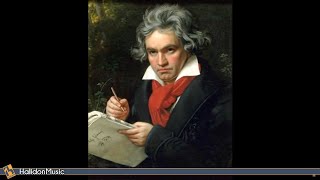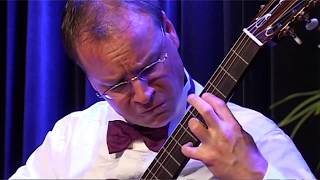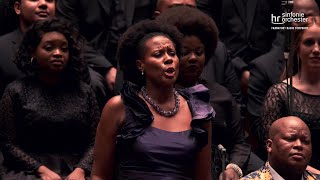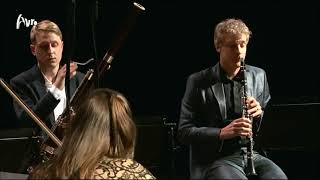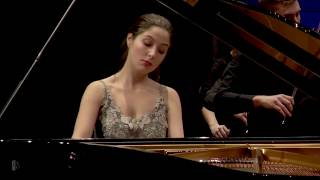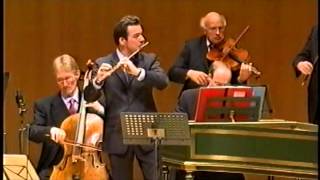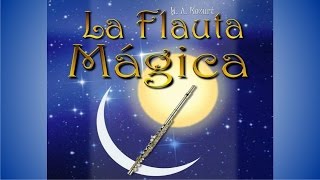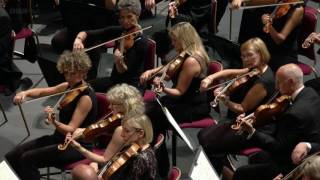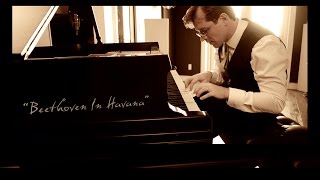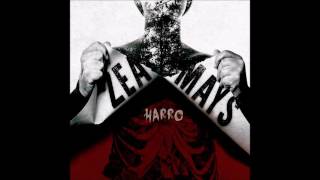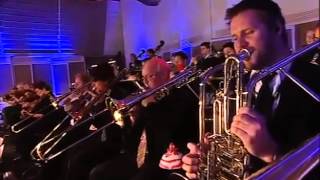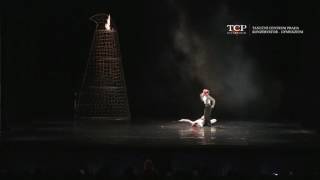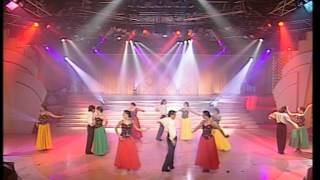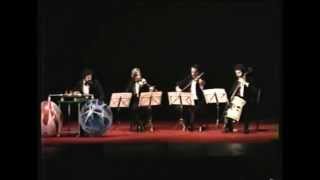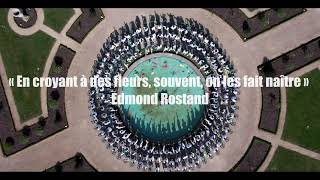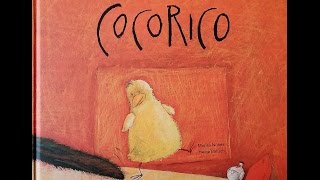On December 16, 1770, Beethoven was born.
Recommended music videos for initiation to classical music
Ludwig van Beethoven (1770-1827) together with Bach and Mozart is part of the trio of giants of Western music. Born in Bonn , his father, of Flemish origin, tried to make him a second Mozart , although it was a notable failure. Despite this, from the age of nine the organist Christian Gottlob Neefe captivated him with the study of Bach , whom he would always keep in mind. In 1787 he moved to Vienna with the intention of taking Mozart classes, but the death of his mother returned him to Bonn a few days later. And so after five years, he returned to Vienna where he contacted Haydn and Salieri , becoming known as a composer and pianist with notable public recognition. However, his profession as a pianist could not be carried out due to deafness that attacked him the following year, leaving him completely incapable of this faculty.
The video we present today offers some of its coolest passages. 1 (00:00) Symphony No. 3, Eróica - I Allegro con brio .-. 2 (13:46) Symphony No. 5 - I Allegro con brio .-. 3 (21:02) Symphony No. 6, Pastoral - III. Allegro .-. 4 (26:04) Symphony No. 6, Pastoral - V. Allegretto .-. 5 (35:34) Symphony No. 7 - II Allegretto .-. 6 (38:56) Symphony No. 7 - III. Presto.-. 7 (42:24) Symphony No. 9 - Ode to Joy .-. 8 (1:07:38) Piano Sonata No. 14, Moonlight Sonata - I Adagio Sostenuto .-. 9 (1:11:47) Bagatelle No. 25 Für Elise .-. 10 (1:14:24) Rondo a Capriccio Rage Over a Lost Penny .-. 11 (1:21:53) Minuet in G major, WoO 10, No. 2 .-. 12 (1:24:24) Duet for Clarinet and Bassoon .-. 13. (1:28:17) Piano Concerto No. 5 Emperor Concerto - II. Adagio .-. 14 (1:35:06) Piano Sonata No. 8 Pathétique - II. Adagio .-. 15 (1:40:16) Violin Concerto
Leo Brouwer (Havana, March 1, 1939) is a Cuban composer, guitarist and conductor. He is the grandson of Ernestina Lecuona de Brouwer , great-nephew of Ernesto Lecuona and cousin of Margarita Lecuona . He began playing guitar at the age of 13, attracted by the flamenco sound and motivated by his father Juan Brouwer , who was a doctor and amateur guitarist. He gave his first recital at the age of 17, although by this time his compositions had already begun to attract attention. He has more than three hundred international artistic and academic distinctions, among them: the “Manuel de Falla” Prize (1998); the Honoris Causa Doctorate at the University of the Arts (ISA) in Havana and at the University of Santiago de Chile ; two Latin Grammys , etc, etc
The Guitar is a plucked string instrument, unlike the piano, which has a struck string , or the violin, which has a bowed string . After centuries of evolution, the current guitar is made up of the sound box that has a large hole or mouth at the top, the neck that is covered by the six strings that go from the bridge to the headstock whose pegs are used to tune the strings. ; On the other hand, the neck is covered by a piece of wood that is the fingerboard divided into frets that divide the strings into halftones. The origin of the guitar dates back to 1000 years BC where the Assyrians already had plucked string instruments with a sound box. The six-string guitar was introduced in the 18th century by Jacob Otto with the current tuning.
George Gershwin (1898 –1937) was an American composer appreciated for having known how to combine jazz with classical music . From a young age he began to write his first songs, premiering his first musical on Broadway with his brother Ira as lyricist, a company that he would never leave. From the age of twenty he began to compose works designed for concert halls with which he obtained renowned successes. Aware of his formal deficits, he traveled to Paris to complete his training with Stravinsky , who, after asking him about the money earned in a year, replied that he was the one who should take classes with Gershwin . Something similar happened to Ravel , as he said, “Why do you want to be a second-rate Ravel , when you can be a first-rate Gershwin ?”
Summertime is a composition by George Gershwin , with lyrics by DuBose Heyward, Dorothy Heyward and Ira Gershwin conceived as an aria for the opera Porgy and Bess , 1935. During the 1950s, the opera had great success in London, Leningrad and Milan . " Summertime " achieved enormous popularity upon the release of Porgy and Bess , and was quickly adopted and adapted as a jazz standard.
Today it is offered to us by the American soprano Adina Aaron accompanied by the Frankfurt Radio Symphony directed by the Colombian maestro Andrés Orozco-Estrada .
Beethoven's musical legacy also includes 32 piano sonatas, numerous works for chamber ensembles, concertos for piano and violin, incidental music, sacred music and, above all, nine symphonies that occupy the zenith of the History of Music . To understand it better, we can divide this legacy into three stages of continuous renewal and improvement: A) Until 1802 . Classicism . His first ten piano sonatas, his first six string quartets, the septimino that we offer today, the first two symphonies and the first two piano concertos belong to him. B) 1803-1814 . Romanticism . In full artistic maturity and with absolute control of the formal structure and lyricism, he composed the symphonies from the 3rd to the 8th, his opera Fidelio , his 3rd, 4th and 5th piano concertos, the violin concerto, the triple concerto, the sonatas for piano “Claro de luna”, “Appasionata” , the Kreutzer Violin Sonata ,… C) 1815 until his death . Innovation of a more intense language with more daring harmonic and structural treatments: five last piano sonatas and five last string quartets, Symphony No. 9 with the incorporation of soloists and choir, Misa Solemnis …
Septet, Op. 20. Within what is popularly called classical music, the best-known septet is possibly the one known as Beethoven's Septimino written for violin, viola, cello, double bass, clarinet, bassoon and horn, and within it, the III Minuet Movement , which is what we will see today in the performance of The Chicago Chamber Musicians , a group founded in 1996 with world-class artists.
Recommended classical music videos
The Piano Concerto No. 5 in E flat major, Op. 73, popularly known as " Emperor ", was Beethoven 's last piano concerto. It was written between 1809 and 1811 in Vienna and is dedicated to Rudolph of Austria , protector and pupil of Beethoven . It was premiered on November 28, 1811 at the Gewandhaus in Leipzig . The nickname " Emperor " was assigned not by Beethoven himself but by Johann Baptist Cramer , the English editor of the concerto.
Structure The concert is divided into the three traditional concert movements: I (0´28´´) ALLEGRO. As in all of Beethoven 's piano concertos, the first movement is particularly long. In the introduction the orchestra plays three chords, each followed by a short cadenza , improvisatory in nature but written in the score. The set is written in sonata form, with three themes, and begins with the particular introduction. The first two themes are introduced by the orchestra in the exposition, but at the end of the second exposition the piano presents a virtuoso and triumphant third theme. The coda of the movement is particularly long and complex.-. II (20'46'') ADAGIO UN POCO MOSSO The second movement has great lyricism, and is undoubtedly the best known of the three movements. The theme is introduced by the orchestra, which is followed by the piano exposition. The theme is repeated three times with different variations. The coda ends by slowly introducing the main theme of the third movement.-. III (28´03´´) RONDO - ALLEGRO MA NON TROPPO. The third movement follows the second uninterruptedly and is a typical Italian rondo, of the form ( A B A C A B A ). The main theme is played by the piano and then responded to by the orchestra. Scales on the piano introduce the second theme, which is also answered by the orchestra. In the much longer section C , theme A is presented in three different keys.
Alina Elena Bercu (1990) is a Romanian concert pianist. He began his first piano lessons at the age of 7 at the School of Arts in his hometown, Campina . In 1999 he settled with his family in Brasov , Transylvania, to study with Stela Drăgulin of the Faculty of Music. At only 16 years old, she passed the entrance exam at the Franz Liszt University of Music in Weimar, Germany, becoming a student of Grigory Gruzman , while simultaneously attending courses at the Andrei Saguna National College in Brasov . He gave his first concert with an orchestra when he was only 9 years old, and soon performed on prominent stages in Europe, America and Asia . He has given more than 200 concerts with renowned orchestras and made recordings for different European stations.
Johann Sebastian Bach (1685-1750) was a German violinist, organist, conductor and composer, born in Eisenach into the most prominent musical family in history. In 1703 he obtained his first job in Arndstat and in 1707 he moved to Mülhausen as an organist, where he married his cousin Maria Barbara with whom he had seven children. After the death of his wife in 1720, he remarried Mary Magdalene with whom he would have another thirteen children. In 1723 he moved to Leipzig where he would reside until his death at the age of 65. Considered one of the three main geniuses in the History of Music along with Mozart and Beethoven, his influence has been notable on Haydn , Mozart , Beethoven , Mendelssohn , Schumann , Chopin ... and many other renowned composers.
The Suites for Orchestra , BWV 1066-1069 (called ouvertures by their author), are four pieces that Johann Sebastian Bach wrote between 1725 and 1739 in Leipzig . In a broad sense, the term suite was used in Baroque Germany to refer to a series of dance pieces preceded by an ouverture .
Orchestral Suite no. 2. Structure : I (0´08´´) OUVERTURE .-. II (6'37'') RONDEAU .-. III (8'15') SARABANDE .-. IV (11´03´´) BOURRÉE .-. V (12´50´´) POLONAISE .-. VI (16'02'') MINUET .-. VII (17'09'') BADINERIE. Today it is offered to us by the French-Swiss flutist Emmanuel Pahud accompanied by the Berlin Baroque Soloists ensemble.
Mozart and Freemasonry . Freemasonry appeared in Europe at the end of the 17th century as a selective group of philanthropic nature, with a federal structure and with humanistic objectives, such as the search for truth, the study of human behavior, the sciences and the arts and the social and moral development of people and society; all of this based on a feeling of brotherhood, whose teachings are symbolized with elements of masonry. Taking these objectives into account, at the age of 28 Mozart entered the Masonic Lodge of Vienna as an apprentice ; The following month he rose to the rank of Companion and four months later he was named Master Mason . Influenced by the Enlightenment , he pursued rationalism, although without joining the occult character of many of his companions.
The Magic Flute , whose viewing today we suggest, is an opera that was premiered in Vienna conducted by Mozart himself two months before his death. The opera, rather the singspiel (mixes sung text with spoken text), was commissioned by a fellow lodger, the theater entrepreneur Emanuel Schikaneder , who wrote the libretto himself; They were days of economic hardship and commissions for Mozart . The work tells in two acts the love story between Prince Tamino and the young Pamina , daughter of the Queen of the Night . It all begins when the Queen promises Tamino to give him the hand of her daughter, for which Tamino must overcome a series of tests that point to the fight between good and evil, light and darkness, knowledge and ignorance; all approaches, fundamental in Masonic doctrine. A kind of fairy tale with frequent comic scenes; but full of Masonic symbology in the incarnation of the characters, in the development of the action and even in the musical structures beginning with the first sounds of the orchestra: three orchestral touches that reflect the three touches that the Mason candidate makes on the door to apply for admission.
The version that we offer today from the Zurich Opera House is conducted by the Austrian maestro Franz Welser-Möst .
Symphony . The word symphony derives from the Latin symphonĭa and this in turn from the Greek συμφωνία (symmphōnía), which means "consonance" as opposed to διαφωνία (diaphōnia), which means "dissonance." In the Middle Ages and later, the word symphony was used to describe various instruments, especially those capable of producing more than one sound simultaneously; in the sense of "sounding together", the word begins to appear in the titles of some works by composers of the 16th and 17th centuries and by the end of the 18th century the word had already acquired the common meaning that is currently assigned to it: a work that generally consists of four different sections or movements and composed most of the time for orchestra.
The symphony from Romanticism . Beethoven 's symphonies usually had a first movement “Allegro” in sonata form (exposition of two or more contrasting themes, development and reexposition with or without coda ), a slow second movement (sometimes in the form of theme and variations ), a third movement with ternary rhythm (usually a scherzo ; although before Beethoven the common thing was a minuet and trio ), to end with the fast fourth movement (usually in the form of a rondo ); although there are symphonies with a last movement also written in sonata form .
Beethoven's Ninth Symphony is one of the most important musical compositions in history. The last movement caused astonishment in its time by the incorporation of a vocal quartet of soloists and mixed choir, something unprecedented at that time; movement, on the other hand, that has become a symbol of freedom. In our days it has had countless arrangements and adaptations from the Hymn to Joy by Miguel Ríos until Herbert von Karajan 's arrangement to make it the Anthem of the European Community ; The text he uses is a reduction of the Ode to Joy by the German poet Friedrich Schiller . The Symphony consists of four movements and its premiere took place in Vienna on May 7, 1824 with resounding success with Beethoven present. On January 12, 2003, UNESCO declared the Symphony a World Heritage Site.
Structure . The symphony has four movements: I (0´06´´) Allegro ma non troppo, un poco maestoso, in D minor. The Symphony begins powerfully, with a main theme that runs through frenetic scales and variations, with passages later for lyrical moments, again interrupted by the titanic intensity of the composition. II (14´50´´) Scherzo. Molto vivace, in D minor – Presto, in D major. The second movement is described by some chroniclers as "hell in flames", due to its forcefulness and speed, majestically softened in the recapitulation. III (26´41´´) Adagio molto e cantabile, in B flat major – Andante moderato – Tempo Primo – Andante moderato – Adagio – Lo stesso tempo. The third movement, although sedate, leads firmly into what will become the fourth movement, which contains an easily recognizable and world-famous original Beethoven melody. IV (39´13´´) Finale. Recitative (Presto – Allegro ma non troppo – Vivace – Adagio cantabile – Allegro assai – Presto: O Freunde) – Allegro assai: Freude, schöner Götterfunken – Alla marcia – Allegro assai vivace: Froh, wie seine Sonnen – Andante maestoso: Seid umschlungen, Millionen! – Adagio ma non troppo, ma divoto: Ihr, stürzt nieder – Allegro energico, semper ben Marcato: (Freude, schöner Götterfunken – Seid umschlungen, Millionen!) – Allegro ma non Tanto: Freude, Tochter aus Elysium! – Prestissimo, Maestoso, Prestissimo: Seid umschlungen, Millionen! presto allegro tempo. The movement begins with brief recapitulations of the previous movements. Finally, the bass bursts in with a call: "Friends, not in those tones...", after which the melody based on the ode sounds, first through the orchestra and then with the choir. When the choir intervenes, it generally does so in a homophonic manner. It constitutes a grandiose musical architecture with diverse textures that range from recitative to double fugue, including soloists, chorus, etc.
Today it is offered to us by soprano Erin Wall , mezzo-soprano Sonia Prina , tenor Simon O'Neill and bass Alexander Vinogradov with the CBSO Choir , the BBC National Choir of Wales and the BBC National Orchestra of Wales , all They are conducted by Chinese teacher Xian Zhang .
Recommended music videos for all tastes
Rumba is a genre of traditional music that originated in Cuba during the 19th century . With African roots, the Cuban rumba is considered the mother of numerous Latin rhythms and dances, such as salsa , and has derivations in various Latin American countries. In November 2016, UNESCO inscribed the Cuban rumba , a festive mix of dance and music, and all inherent cultural practices as a member of the Representative List of the Intangible Cultural Heritage of Humanity .
Today Joachim Horsley offers us an arrangement, rumba version, of the 2nd Movement of Beethoven 's Seventh .
June Christy (1925-1990), was an American jazz singer. She became known as a singer with the Stan Kenton Orchestra, before starting a successful solo career in 1954 that led her to be recognized as the most representative voice of Cool Jazz of the 1950s. He moved to Chicago in the early 1940s, where he joined a group led by Boyd Raeburn as vocalist. In 1945 he joined Stan Kenton's orchestra. When Kenton 's orchestra dissolved in 1948, Christy worked on the nightclub circuit until reuniting with Kenton in 1950. From 1972 onwards he began participating in more jazz festivals. In 1977 he recorded his last album, Impromptu and in 1988, his last performance, sharing the stage with Chet Baker .
Zea Mays is a rock musical group that emerged in Bilbao in 1997, made up of Asier Basabe (drums), Rubén González (bass), Iñaki Imaz (guitar) and Aiora Renteria (singer). In 1997 they recorded a demo, with which they won the Basque Country Youth Model Contest . The award gave them a great boost and thanks to it they scheduled several concerts throughout the Basque Country . In 1998, they were considered the best Basque band in the Bilbao pop-rock contest. In 1998 they recorded their first album, the eponymous Zea Mays , which would be followed in successive years by Elektrizitatea , Harrobian , Sortuz, grabitatearen aurka while they toured Germany and the Netherlands . In 2007, already with ten years of experience, they released the new work Morphina ; Then came Era Da and Harro , which we offer today.
Salsa is a dance musical genre resulting from the synthesis of Cuban son and other genres of Caribbean and American music such as jazz and blues . Salsa was consolidated as a commercial success by musicians of Puerto Rican origin in New York in the 1960s, and by the work of its main composer, the Dominican Johnny Pacheco , although its roots go back to previous decades in countries of the Caribbean basin. Eventually, salsa spread throughout Latin America , giving rise to abundant regional variants. Despite everything, although Cuban son is the backbone of salsa, the fundamental element in the emergence of salsa is the role of Puerto Rican musicians and their culture, both on the island of Puerto Rico and in its New York diaspora.
In this video Kyle Johnson offers us an arrangement, a salsa version, of the first Movement of Beethoven 's Fifth .
Recommended peculiar videos
Beethoven 's The Creatures of Prometheus is a ballet in two acts premiered in 1801 and considered the first large-scale dramatic ballet. The plot is the work of Salvatore Viganò (1769-1821), dancer and poet, and is about Prometheus , a demigod with a sublime spirit who regenerated the human race through the sciences and arts; As protector of human civilization, he stole fire from the gods to bring it from Mount Olympus to earth.
Today's version is offered to us by the Prague Dance Center with the Smíchov Chamber Philharmonic .
The legend of the kiss is a zarzuela in two acts, divided into three paintings, with a libretto by Enrique Reoyo, José Silva Aramburu and Antonio Paso , and music by the maestro Reveriano Soutullo and Juan Vert . It premiered with great success at the Teatro Apolo in Madrid on Friday, January 18, 1924.
Today the Alhambra Ballet offers us a choreographed version of its famous Intermedio that was performed, among other artists, by the group Mocedades in the song Amor de hombre .
Les Luthiers is an Argentine musical-humorous group, very popular in their country and in other Spanish-speaking countries. The group uses music as a fundamental element of their performances, frequently incorporating informal instruments created from materials from everyday life. From this characteristic comes its name, luthier , a word from the French language that designates the creator, adjuster and person in charge of repairing stringed musical instruments. They have been recognized with illustrious distinctions both in their native Argentina , as well as in Spain and the USA.
From Cambo (Iparralde/North Euskadi) this disciplined Choeur des Colibris from the Saint Michel Garicoïts School directed by the teacher and author of this arrangement, Nelly Guilhemsans , offers us this original body percussion accompaniment to the First Movement of Beethoven's Fifth . With this video we close our humble tribute this year to the Master of master composers in the History of Music, Ludwig van Beethoven .
Recommended music videos for children
Various Wikipedia articles have been used to write these texts.
The texts of Videomusicalis are written in Basque, Spanish and English.





